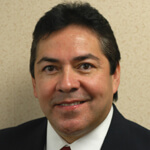
San Antonio (July 27, 2004) – Minimally invasive neurosurgical craniofacial procedures are now available to children across South and Central Texas and nationwide, thanks to the arrival of David F. Jimenez, M.D., and his wife, Constance M. Barone, M.D., at The University of Texas Health Science Center at San Antonio. Both surgeons, who are fellows of the American College of Surgeons and the American Academy of Pediatrics, were recruited from the University of Missouri at Columbia.
Dr. Jimenez is professor and director of the Center for Neurosurgical Sciences in the Health Science Center’s School of Medicine. Board certified in general and pediatric neurosurgery, he is a graduate of Temple University School of Medicine in Philadelphia.
Dr. Barone is head of the Health Science Center’s division of plastic and reconstructive surgery. She earned her medical degree from the Mount Sinai School of Medicine in New York. She is board certified in plastic and reconstructive surgery and fellowship trained in craniofacial surgery.

At the University of Missouri, Dr. Jimenez served as director of the neurosurgery residency training program, director of the surgical epilepsy program and co-director of the center for craniofacial disorders and the pediatric neuro-oncology program (both at the university’s affiliated Children’s Hospital). Steven A. Wartman, M.D., Ph.D., executive vice president for academic and health affairs and dean, School of Medicine, said Dr. Jimenez brings “a superb mix” of leadership, academic and clinical skills to his new position.
“Dr. Jimenez and Dr. Barone have pioneered the development of a unique surgical procedure for craniosynostosis, a debilitating disorder affecting infants,” Dr. Wartman said. “Children afflicted with this problem have come to them from all over the world to receive this procedure. In addition, Dr. Jimenez brings significant expertise in the area of neuroendoscopy, where he has been able to diagnose and treat complex and deep brain lesions via a small surgical hole rather than using large and extensive craniotomies.”
In the May issue of Journal of Neurosurgery: Pediatrics, Drs. Jimenez, Barone and three co-authors reviewed new procedures for the management of sagittal craniosynostosis. Infants born with this condition have narrow, elongated heads prompted by abnormal bone development. In many cases the sagittal suture closes too early and restricts normal growth. The condition occurs in an estimated 1 in 1,000 to 1 in 3,000 births.
For decades, the disorder required extensive surgery with a large operating window in the skull and risk of substantial blood loss. During the past seven years, endoscopy-assisted techniques have begun to change the way it is treated. An endoscope is an instrument that enables physicians to look inside a hollow organ, in this case the cranial cavity or skull.
The couple developed “endoscopic strip craniectomies” to treat the condition and have performed the procedure more than any other surgical team in the world. The procedure lasts about an hour compared to the traditional three to seven hours of surgery. The smaller incisions result in shorter hospital stays and greatly diminished scarring and pain for the infants.
Drs. Jimenez and Barone have extensive lists of publications, awards, memberships and honors. While at Missouri, they established an exchange program to educate Filipino health care providers and treated more than 250 patients on trips to the archipelago.
Since their arrival, Drs. Jimenez and Barone have performed surgeries at University Hospital, the Health Science Center’s primary teaching hospital.
To view a biosketch of Dr. Jimenez, visit: www.uthscsa.edu/HSCNews/archive/Jimenez.pdf
To view a biosketch of Dr. Barone, visit: www.uthscsa.edu/HSCNews/archive/Barone.pdf

